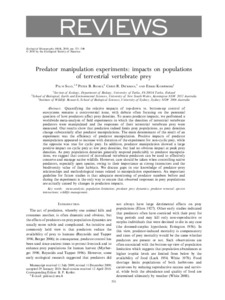| dc.contributor.author | Salo P | |
| dc.contributor.author | Korpimäki E | |
| dc.contributor.author | Dickman CR | |
| dc.contributor.author | Banks PB | |
| dc.date.accessioned | 2022-10-28T13:55:43Z | |
| dc.date.available | 2022-10-28T13:55:43Z | |
| dc.identifier.uri | https://www.utupub.fi/handle/10024/168333 | |
| dc.description.abstract | Quantifying the relative impacts of top-down vs. bottom-up control of ecosystems remains a controversial issue, with debate often focusing on the perennial question of how predators affect prey densities. To assess predator impacts, we performed a worldwide meta-analysis of field experiments in which the densities of terrestrial vertebrate predators were manipulated and the responses of their terrestrial vertebrate prey were measured. Our results show that predation indeed limits prey populations, as prey densities change substantially after predator manipulations. The main determinant of the result of an experiment was the efficiency of predator manipulation. Positive impacts of predator manipulation appeared to increase with duration of the experiment for non-cyclic prey, while the opposite was true for cyclic prey. In addition, predator manipulation showed a large positive impact on cyclic prey at low prey densities, but had no obvious impact at peak prey densities. As prey population densities generally respond predictably to predator manipulations, we suggest that control of introduced vertebrate predators can be used to effectively conserve and manage native wildlife. However, care should be taken when controlling native predators, especially apex species, owing to their importance as strong interactors and the biodiversity value of their habitats. We discuss gaps in our knowledge of predator-prey relationships and methodological issues related to manipulation experiments. An important guideline for future studies is that adequate monitoring of predator numbers before and during the experiment is the only way to ensure that observed responses in prey populations are actually caused by changes in predation impacts. | |
| dc.language.iso | en | |
| dc.publisher | ECOLOGICAL SOC AMER | |
| dc.title | Predator manipulation experiments: impacts on populations of terrestrial vertebrate prey | |
| dc.identifier.urn | URN:NBN:fi-fe2021042714782 | |
| dc.relation.volume | 80 | |
| dc.contributor.organization | fi=ekologia ja evoluutiobiologia|en=Ecology and Evolutionary Biology| | |
| dc.contributor.organization-code | 2606402 | |
| dc.converis.publication-id | 2678510 | |
| dc.converis.url | https://research.utu.fi/converis/portal/Publication/2678510 | |
| dc.format.pagerange | 531 | |
| dc.format.pagerange | 546 | |
| dc.identifier.jour-issn | 0012-9615 | |
| dc.okm.affiliatedauthor | Salo, Pälvi | |
| dc.okm.affiliatedauthor | Korpimäki, Erkki | |
| dc.okm.discipline | 1181 Ekologia, evoluutiobiologia | fi_FI |
| dc.okm.discipline | 1181 Ecology, evolutionary biology | en_GB |
| dc.okm.internationalcopublication | international co-publication | |
| dc.okm.internationality | International publication | |
| dc.okm.type | Journal article | |
| dc.publisher.country | Yhdysvallat (USA) | fi_FI |
| dc.publisher.country | United States | en_GB |
| dc.publisher.country-code | US | |
| dc.relation.doi | 10.1890/09-1260.1 | |
| dc.relation.ispartofjournal | Ecological Monographs | |
| dc.relation.issue | 4 | |
| dc.year.issued | 2010 | |
